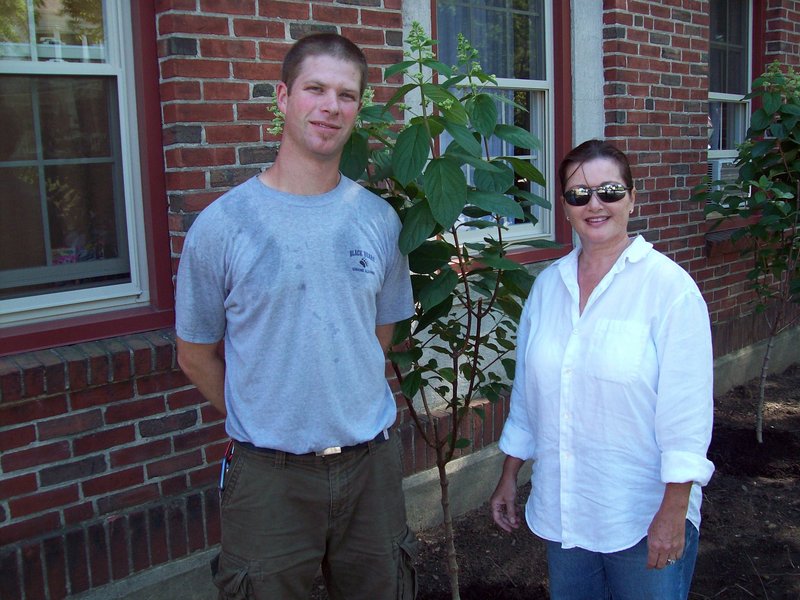An apartment building designed by John Calvin Stevens at 244-246 Woodford St. in Portland just got a new garden that will make the building look more like it would have shortly after it was built in 1931.
The owner, Neils Knudsen, got what he wanted. “I just wanted to get rid of the yews,” he said, saying that the tall evergreens covered most of the front of the building.
Lindsay Knapp, who lives in the building and designed the garden, also got what she wanted, but her desires were more extensive. For starters, she wanted to make the landscape more up to date but in keeping with the style of the building.
First, a bit on the building. When I first went to see Knudsen and Knapp, I drove by the building three times before I figured out which building it was. I had expected a shingle-style cottage with pitched roofs, gables and nooks and crannies. But this building is brick and mostly rectangular. It has 19 apartments, and a square courtyard in the front.
“My great-grandfather was the first owner,” Knudsen said. “He was the plumber on the project for Clough and Maxim, the builders, and he got it in a builder’s lien. I’ve owned it for five years and my father, Erik, bought it back in 1997. It was out of the family from 1960 to 1997.”
Knudsen owns another John Calvin Stevens brick apartment building, on State Street in Portland.
Knapp said she designed the garden with the public in mind.
Woodford Street has a lot of traffic, and the people driving by should be able to enjoy seeing such a significant building and the garden that goes with it.
“This is the kind of community gardening I want to promote,” Knapp said. “This is a gift to the community, right out front where people can see it.”
And Knudsen did have a little more in mind than getting rid of the yews.
“It is my business card, my handshake to the world,” he said. “It is the first thing my customers, potential renters, will see.”
The garden so far includes 12 Sargent crabapple hybrids and 15 Hydrangea paniculata “Pink Delight.” The mulch had not been put down when I visited, but it was scheduled.
Knapp is planning an undercover of bunchberry and cinnamon ferns, both natives, once Knudsen is ready to tackle another project.
Knudsen handled all the labor himself, including plant removal, soil preparation and planting, and he spent a little under $2,000 on the plants.
“When John Calvin Stevens designed this building he did not foresee the level of traffic we have now,” Knapp said. “The U-shape seems to capture the sound, and this garden will soften it.”
If Knudsen ever has to replace the brick walkways and the garden of lady’s mantle, hosta and other perennials in the middle of the walkways, she would like to add a few mountain laurels for another kind of shrub and to further deaden the traffic sound.
To a person walking by the apartment building, the garden will look sparse, if not exactly empty. Knapp is perfectly happy with that.
“This is a garden plan for 20 to 30 years from now, maybe even 20 to 50,” she said. “When I look at this garden, I see how it will look in 30 years. These are all toddler plants.”
She knows that, at age 56, she might not see this garden when it is in its prime, but will see how a line of hydrangeas will look, blooming in mid-July and hanging onto those blossoms until the following spring. She knows how large the crabapples will grow with their branches spreading out 6 feet to each side.
“Gardening is an immediate thing; you get out there and plant and weed,” she said. “But design is for the long term, it is for the future.”
I agree with Knapp, but I look at it a different way, with my hands on the loppers rather than my eye to the future. The plants were placed far enough away from each other so they will fit comfortably when they are full grown. This is called low-maintenance gardening.
Too often, homeowners and some landscape firms cram a garden full of plants, so it looks good when it is planted. And in three years, the home- owner says, “Everything is so big. It is out of control.”
And then you spend hours pruning back the shrubbery so they don’t crowd each other out. The plants never get a chance to reach their full beauty as mature specimens.
The garden is stuck with toddler plants forever.
If the sparse look of the garden bothers you in the early years, plant a lot of annuals until the garden nears maturity.
I know a lot of people don’t like spending money on annuals, because you have to buy them each year, but I’m going to offer a slight lesson in finances.
Figure out how much extra money you would spend on an overcrowded garden compared to what you would spend on the properly planted garden. You are buying fewer plants, so you are going to save money.
Put that money in a separate account, and every year buy annuals with that fund until the money runs out. And when the money runs out, the garden will probably be mature.
Tom Atwell can be contacted at 791-6362 or at:
tatwell@pressherald.com
Send questions/comments to the editors.


